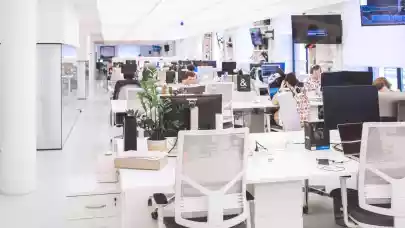
As for the whole of 2022, the annual new supply of office space represents approximately 75,400 sqm. Although the annual supply of newly-completed space increased by 34% year-on-year, total volume was again below the long-term average of approximately 130,000 sqm per year. 2023 is expected to bring about some changes and more extensive construction. This means the Prague office market should grow to the 4 million sqm mark by 2025. Also at the close of 2022, several consecutive quarters of rent price growth came to a halt. These findings come from a survey by Colliers.
Most of the projects completed during 2022 still offer brand new vacant space, with approximately 38,700 sqm currently available in 7 projects scattered across the Prague 1, 5, and 8 sub-markets. These include a building called the Na Knížecí Office, which was the only project completed in Q4 2022. That quarter turned out to be the weakest last year in terms of completed construction projects. The overall vacancy rate currently stands at 7.7%, representing approximately 293,600 sqm of vacant space. As no new construction began during Q3 and Q4 2022, a larger supply of new space can be expected in 2025. This is mainly due to developers' plans to start construction of up to 300,000 sqm of office space in 2023.
Net realised demand up 40% year-on-year
Prague’s leasing market ended the year strongly with 151,800 sqm of gross take-up. This was the highest gross volume for 2022 and the highest since Q4 2018. However, the net take-up share was lower than in the previous quarters of last year. “ In absolute numbers, we registered 60,600 sqm in new leases, expansions, or pre-leases. In percentage terms, it was only 40%. The largest deal recorded in Q4 was the renegotiation of the lease for telco operator O2, which occupies the entire Gamma Building in Brumlovka in Prague 4. That space has a size of 29,000 sqm. That deal was also the largest in 2022,” comments Josef Stanko, senior analyst at Colliers. He adds: “Figures for all of 2022 are impressive. Gross take-up reached a record volume of 547,300 sqm, slightly higher than figures for the most successful years: 2017 and 2018. In comparison with the two years mentioned, we registered a significantly higher share of renegotiations in 2022. Approximately 46% compared to 28% in 2017 and 34% in 2018. Net take-up volume accounted for 294,100 sqm, which is approximately a 40% increase year-on-year.” Sector-wise, technology companies were responsible for 27% of gross take-up during 2022; followed by financial (11%) and pharmaceutical companies (9%). Shares of net take-up were roughly similar to those for gross figures.
Rent growth stopped
As the year came to a close, the race for rent increases seems also to have stopped: or at least slowed down. The main benchmark indicator, Prague’s prime office rent price, was approximately €26.50 per sqm per month in Q4 2022 – the same as for the previous quarter. Some projects offer smaller units for prices of over €30 per sqm, but those are considered one-off transactions. Prime rent rates for top city locations like Brumlovka, Pankrác or Karlín currently range between €17.50 and €18.00 per sqm per month. Rates for space in prime offices on the city periphery, locations like Nové Butovice, Vysočany or The Park in Chodov, can reach up to €16.00 per sqm per month. Due to the average inflation rate in 2022 (EU HICP 8.5% and CZ CPI 15.1%), overall rent levels are expected to increase. Rents in existing properties will start to close the gap against higher rent levels in new developments. However, the existing stock of office space, especially older offices without modern features or certifications, can hardly justify any major rent increases without proper investment.
A search for new ways of construction
In 2023, we can expect further market stabilisation. In upcoming months, there will be approximately 184,000 sqm of new office space under construction with 129,000 sqm scheduled for this year. For the next several months, the majority of take-up is expected to come from renegotiations. “On one hand, this is due to low vacancies and a lack of options for potential new occupants. On the other hand, the market has been impacted by current economic uncertainties, cuts in employee headcounts, and pressure to save on some operating expenses,” explains Stanko.
Investors and long-term real estate holders will also try to improve their portfolios with regard to environmental and social compliance. Some developers are openly looking for alternative approaches to, and pioneering new ways of, construction: i.e., the use of timber, low-emission cement, and other materials. “This year, it will be crucial for industry leaders to push and openly call for changes to construction legislation (regulations) in the Czech Republic. Limits on how a building can be done are also set in those norms, and it is important for the real estate sector to point out and engage in discussion on regulatory shortcomings,” concludes Josef Stanko.



